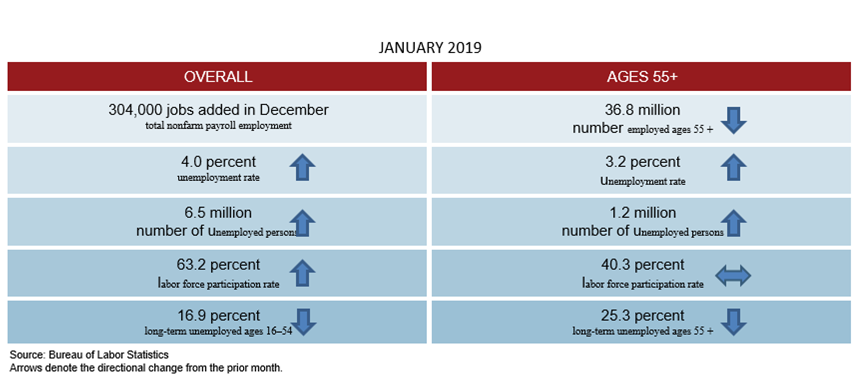AARP Hearing Center
55+ Unemployment Increases to 3.2 Percent
By Jennifer Schramm, February 1, 2019 06:06 PM

Employment Overview
The unemployment rate increased to 4.0 percent in January according to the Bureau of Labor Statistics (BLS). BLS revised the methodology for calculating employment statistics. Underlying survey data have been revised as part of the annual benchmarking process, updating of seasonal adjustment factors, and updated population estimates. For more information, see The Employment Situation.
Overall, the economy added 304,000 jobs in January, up from 222,000 jobs added in December (revised down from +312,000). The unemployment rate for those ages 55 and older increased to 3.2 percent, up from 2.9 percent in December. The labor force participation rate for the 55+ remained unchanged at 40.3 percent. Employment among the 55+ age group declined slightly to 36.8 million. Among this age group, 1.2 million were unemployed.
Spotlight: The Declining Labor Force Participation of Men Ages 25 to 54
The labor force participation rate (LFPR) of the “prime-age” male workforce – i.e., men ages 25 to 54 – increased slightly during 2018 as the economy continued to grow. Nevertheless, for more than 60 years the trend for this group of US workers has been one of decline. While the prime-age male LFPR reached almost 98 percent in the 1950s, it has since decreased, remaining at around 88 percent over the past few years. The LFPR of men ages 55 to 64 has also remained steady in the past decade at around 70 percent, although it edged up and reached almost 72 percent in 2018.
Meanwhile, in recent years, the LFPR of men ages 65 and older has trended up; the 65+ male LFPR fell as low as 14.8 percent in 1991, but by 2018 it had increased to 24 percent. Nevertheless, the increasing participation of both men and women ages 65 and older in the workforce only partially offsets the loss of prime age men from the labor force.
These declines worry both economists and policymakers. Because workers ages 25 to 54 are in their main earning years, a growing number remaining outside of the workforce will have implications for individual lifetime earnings, savings, and living standards. LFPRs and employment rates for this demographic have dropped at a higher rate in the United States than in other comparable countries. Although these rates have varied by educational attainment since the 1960s, the trend affects men at all education levels. Men in the middle educational categories group – i.e., those with only a high school degree, some college, or an associate’s degree – have had the largest increase in nonparticipation, which some economists attribute to decreasing demand for middle-skilled workers for jobs requiring some education beyond high school but not a four-year degree.
Find more details on the latest employment data in the January Employment Data Digest, PPI’s monthly review of job trends for those ages 55 and over. Learn more about data to drive policy solutions, and discover information on skills, jobs, and occupations for the 50+.

Jen Schramm is a senior strategic policy advisor at the AARP Public Policy Institute. Her areas of expertise include employment trends, policy challenges and opportunities related to workers and jobseekers ages 50 and above, and skills and credentialing for mid- and late-career workers.































































